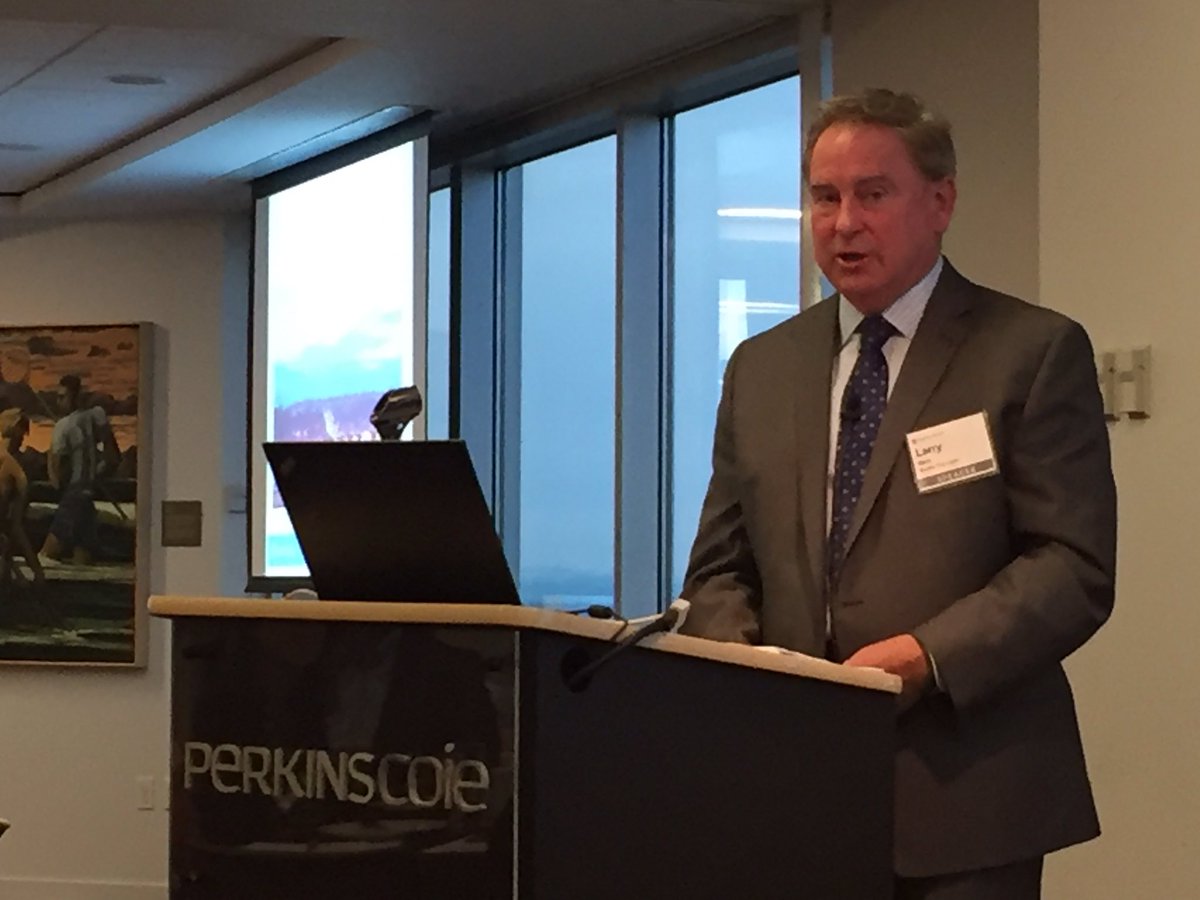|
 Energy delivery used to be very similar across the country. That’s no longer the case, according to Larry Weis, General Manager and CEO of Seattle City Light. Now, every utility and every market are different. What works at Austin Energy doesn’t necessarily apply at Seattle City Light, so Weis had to leave his Texas tools behind when he returned to the Northwest earlier this year. Energy delivery used to be very similar across the country. That’s no longer the case, according to Larry Weis, General Manager and CEO of Seattle City Light. Now, every utility and every market are different. What works at Austin Energy doesn’t necessarily apply at Seattle City Light, so Weis had to leave his Texas tools behind when he returned to the Northwest earlier this year.
Weis outlined regional utility differences and shared his vision for Seattle City Light at the CleanTech Alliance Breakfast Series event held on December 14 at Perkins Coie. The event sold out, packing the Perkins Coie conference center with cleantech industry leaders. Eight CleanTech Alliance member organizations from across Alaska, British Columbia, Alberta, Washington State, Idaho and Oregon also attended via webinar.
Here are 7 key takeaways:
- Reliability and cost are universal. Reliability and cost are the only factors that have not and will not change. Ratepayers want reliable access to electricity at an affordable price…period. Those factors go into every conversation and decision at Seattle City Light – an important consideration when talking strategy and long-term innovation for the utility.
- Ratepayers want participation. The underlying theme in Seattle City Light’s innovation strategy is empowering its ratepayers to participate in their energy system. Typical energy delivery models are going away. Customers want to participate, whether it’s through demand response programs, community solar projects, energy storage or simply installing home automation devices. Weis said Seattle City Light is making that participation possible and is looking for third-party vendors and technologies that can make it happen.
- Microgrids for resiliency. Weis really enjoyed building large renewable energy projects at Austin Energy. He explained that Texas was ripe for utility-scale renewables, but that’s not necessarily the case for Seattle City Light given its limited real estate footprint and abundance of clean hydropower. Instead, Weis wants to build microgrids throughout the city to increase neighborhood resiliency. The utility recently received a $3.5 million Clean Energy Fund grant to build a microgrid that includes a utility-scale battery system, solar panels and emergency generators located at a designated emergency shelter. The specific location has yet to be determined, but the utility intends to build the project where it can support members of the community in times of crisis.
- Energy efficiency is evergreen. Seattle City Light has several very successful energy efficiency programs, so much so that you would expect opportunities to thin out as more and more progress is made. That isn’t the case. According to Weis, there are still a lot of efficiency opportunities to be had as technology advances. Weis is particularly proud of Seattle City Light’s energy efficiency efforts for low and moderate income families, stating that the programs rival those offered by other utilities across the U.S. Moving forward, he sees a tremendous opportunity for impact within multifamily housing. The issue in this scenario is less about technology, however, and more about working with building owners and landlords to make building-level efficiency improvements a priority. Expect to see Seattle City Light continue to push progress in this area for quite some time.
- LEDs have a huge impact. Small LEDs add up to a significant energy savings across Seattle City Light’s network. Lighting typically accounts for 30% of a utility’s load. LEDs are 80% more efficient than traditional bulbs meaning utilities can reduce their energy load by 24% just by encouraging LED use – which is pretty much ubiquitous now. Even the iconic Seattle City Light sign is now lit by LEDs.
- Peak pricing doesn’t pan out. Structuring rates around peak periods and time-of-day pricing doesn’t make a lot of sense in the Pacific Northwest given our moderate climate and abundance of clean, affordable hydropower. Seattle City Light doesn’t see a big enough difference in time-of-day consumption to justify the change. According the Weis, even in the wildest of scenarios, it just doesn’t pan out.
- Cyber security is a real concern, but you should really fear paranoia. There is a lot of rhetoric surrounding grid security. Weis agrees that it is a very real concern, but he fears paranoia surrounding the issue even more. He explained how fear can be a slippery slope. Yes, cyber attacks can cripple the grid and cause a lot of damage, but it cannot shut the system down completely. There’s a reason it’s considered the greatest machine ever build. We don’t want to advocate removing networks from modern software and controls. It’s important to not let paranoia cripple grid modernization and progress.
Want to learn more? Check out the #CleanTechBacon Twitter conversation.
The CleanTech Alliance Breakfast Series is your opportunity to rub elbows with distinguished cleantech executives from across Washington State, the Pacific Northwest and beyond. Sponsored by Perkins Coie, join 100 cleantech industry leaders for a monthly conversation featuring a tremendous lineup of distinguished speakers. Check out our full lineup of executive speakers!
|

 Energy delivery used to be very similar across the country. That’s no longer the case, according to Larry Weis, General Manager and CEO of
Energy delivery used to be very similar across the country. That’s no longer the case, according to Larry Weis, General Manager and CEO of